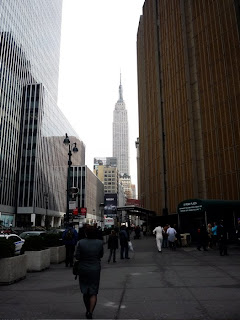Max Beckmann's Last Walk
 |
| The steps of the Metropolitan Museum of Art with poster for the exhibition Max Beckmann in New York. |
Now, 66 years later, the Metropolitan Museum of Art is paying homage to Beckmann and the "poignant circumstances" of his death. On display in Max Beckmann in New York are 39 works that encompass the breadth of his career, including his final ones while a resident of New York City.
In the 1920s, Beckmann thrived in the creative world of Germany's Weimar Republic. He was the subject of major exhibitions celebrating his boldly colorful expressionist paintings, many of them self-portraits. He often painted scenes from the era's famous cabaret culture, and indeed, the paintings on display at the Metropolitan Museum of Art seem to reverberate with the sounds of Cabaret, the 1966 Broadway musical set in 1931 Berlin.
Beckmann was a man about town, a flâneur in the city and at the seashore. His approach to the canvas was brash and bold, with confidant thick brushstrokes and heavy outlining. He was not shy of color contrasts - an orange shirt under a blue coat, for example, or of thick outlines around his figures. He paints himself self-consciously as a thinking man with the cigarette, an intense observer with deeply shadowed eyes.
The rise of the National Socialists doomed his career. They labeled his art as "degenerate" and confiscated 500 of his works. In 1937 he immigrated to Holland, thinking the stay temporary, but the exile lasted ten years. In 1947 he moved to St. Louis, Missouri to teach at Washington University. In 1949 he moved to New York with his wife Quappi.
Before his death, Beckmann was a relative newcomer to the city, settling in the Central Park West apartment in 1949. He accepted a position at the Art School of the Brooklyn Museum. He enjoyed the gaiety of New York's glamorous side, frequenting the Palm Court of the Plaza Hotel and the bar at the St. Regis Hotel, subjects of two side-by-side paintings in the exhibition. Post-war New York was the place to be for an artist of his interests and temperament, "a prewar Berlin multiplied a hundredfold," as he described it.
The New York of Beckmann's last works are often unsettling. The Town (City Night) (1950) shows a debauched city night scene of revelers who've taken the party too far. Much has been made of his New York-era painting, Falling Man (1950), a man falling through a blue sky between burning skyscrapers. A heady mixture of exuberance and anxiety infuses his colorful and bold paintings, all the way from Germany to New York.
Max Beckmann in New York continues through February 20, 2017. The Metropolitan Museum of Art.
Image by Walking Off the Big Apple from October 23, 2016.




